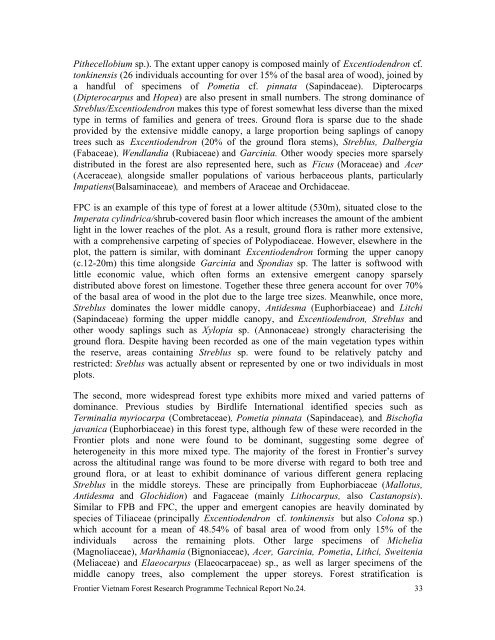Kim Hy Proposed Nature Reserve - Frontier-publications.co.uk
Kim Hy Proposed Nature Reserve - Frontier-publications.co.uk
Kim Hy Proposed Nature Reserve - Frontier-publications.co.uk
Create successful ePaper yourself
Turn your PDF publications into a flip-book with our unique Google optimized e-Paper software.
Pithecellobium sp.). The extant upper canopy is <strong>co</strong>mposed mainly of Excentiodendron cf.<br />
tonkinensis (26 individuals ac<strong>co</strong>unting for over 15% of the basal area of wood), joined by<br />
a handful of specimens of Pometia cf. pinnata (Sapindaceae). Dipterocarps<br />
(Dipterocarpus and Hopea) are also present in small numbers. The strong dominance of<br />
Streblus/Excentiodendron makes this type of forest somewhat less diverse than the mixed<br />
type in terms of families and genera of trees. Ground flora is sparse due to the shade<br />
provided by the extensive middle canopy, a large proportion being saplings of canopy<br />
trees such as Excentiodendron (20% of the ground flora stems), Streblus, Dalbergia<br />
(Fabaceae), Wendlandia (Rubiaceae) and Garcinia. Other woody species more sparsely<br />
distributed in the forest are also represented here, such as Ficus (Moraceae) and Acer<br />
(Aceraceae), alongside smaller populations of various herbaceous plants, particularly<br />
Impatiens(Balsaminaceae), and members of Araceae and Orchidaceae.<br />
FPC is an example of this type of forest at a lower altitude (530m), situated close to the<br />
Imperata cylindrica/shrub-<strong>co</strong>vered basin floor which increases the amount of the ambient<br />
light in the lower reaches of the plot. As a result, ground flora is rather more extensive,<br />
with a <strong>co</strong>mprehensive carpeting of species of Polypodiaceae. However, elsewhere in the<br />
plot, the pattern is similar, with dominant Excentiodendron forming the upper canopy<br />
(c.12-20m) this time alongside Garcinia and Spondias sp. The latter is softwood with<br />
little e<strong>co</strong>nomic value, which often forms an extensive emergent canopy sparsely<br />
distributed above forest on limestone. Together these three genera ac<strong>co</strong>unt for over 70%<br />
of the basal area of wood in the plot due to the large tree sizes. Meanwhile, once more,<br />
Streblus dominates the lower middle canopy, Antidesma (Euphorbiaceae) and Litchi<br />
(Sapindaceae) forming the upper middle canopy, and Excentiodendron, Streblus and<br />
other woody saplings such as Xylopia sp. (Annonaceae) strongly characterising the<br />
ground flora. Despite having been re<strong>co</strong>rded as one of the main vegetation types within<br />
the reserve, areas <strong>co</strong>ntaining Streblus sp. were found to be relatively patchy and<br />
restricted: Sreblus was actually absent or represented by one or two individuals in most<br />
plots.<br />
The se<strong>co</strong>nd, more widespread forest type exhibits more mixed and varied patterns of<br />
dominance. Previous studies by Birdlife International identified species such as<br />
Terminalia myriocarpa (Combretaceae), Pometia pinnata (Sapindaceae), and Bischofia<br />
javanica (Euphorbiaceae) in this forest type, although few of these were re<strong>co</strong>rded in the<br />
<strong>Frontier</strong> plots and none were found to be dominant, suggesting some degree of<br />
heterogeneity in this more mixed type. The majority of the forest in <strong>Frontier</strong>’s survey<br />
across the altitudinal range was found to be more diverse with regard to both tree and<br />
ground flora, or at least to exhibit dominance of various different genera replacing<br />
Streblus in the middle storeys. These are principally from Euphorbiaceae (Mallotus,<br />
Antidesma and Glochidion) and Fagaceae (mainly Lithocarpus, also Castanopsis).<br />
Similar to FPB and FPC, the upper and emergent canopies are heavily dominated by<br />
species of Tiliaceae (principally Excentiodendron cf. tonkinensis but also Colona sp.)<br />
which ac<strong>co</strong>unt for a mean of 48.54% of basal area of wood from only 15% of the<br />
individuals across the remaining plots. Other large specimens of Michelia<br />
(Magnoliaceae), Markhamia (Bignoniaceae), Acer, Garcinia, Pometia, Lithci, Sweitenia<br />
(Meliaceae) and Elaeocarpus (Elaeocarpaceae) sp., as well as larger specimens of the<br />
middle canopy trees, also <strong>co</strong>mplement the upper storeys. Forest stratification is<br />
<strong>Frontier</strong> Vietnam Forest Research Programme Technical Report No.24. 33
















